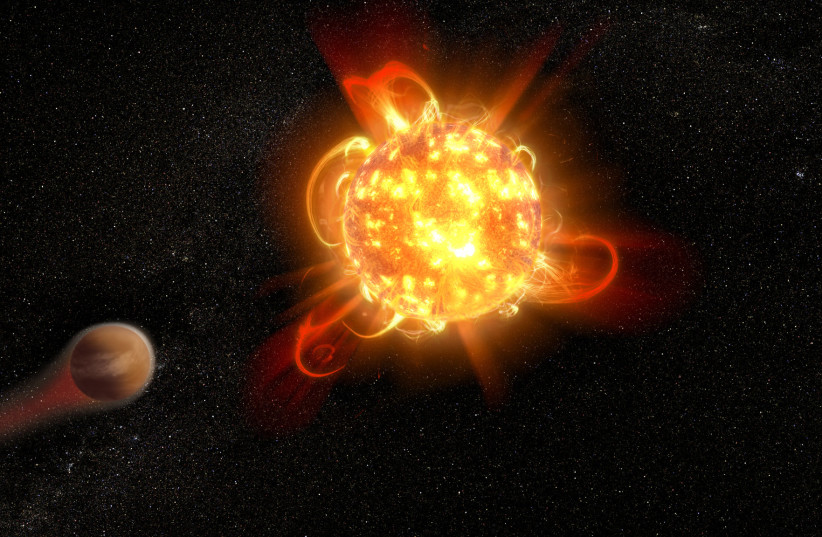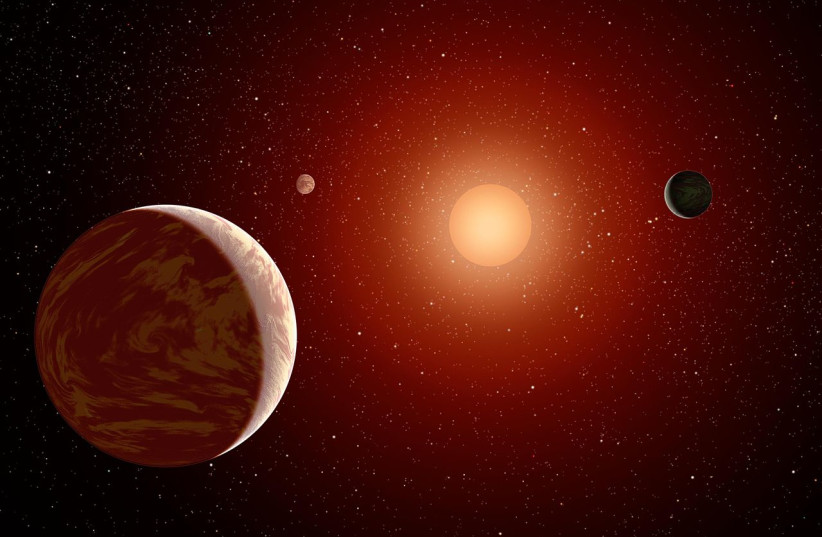The 'forbidden planet': This exoplanet gas giant shouldn't exist - study

The existence of the exoplanet gas giant TOI-5205b around a small red dwarf star should be completely impossible, challenging previously-held theories.
A massive exoplanet has been found orbiting a small red dwarf star just four times larger than it. And according to scientists, this should be impossible, a new study notes.
The existence of the exoplanet in question, a Jupiter-sized gas giant designated TOI-5205b, challenges previously-held theories about the formation of gas giants.
The findings of this study were published in the peer-reviewed academic periodical The Astronomical Journal.
The "forbidden planet": An out-of-this-world discovery
Red dwarf stars, also known as M dwarfs, are the most abundant and commonplace type of star throughout the Milky Way Galaxy, as well as the smallest and coolest kind.
They can be differentiated from other stars, like the Sun, which is a G-type main-sequence star also known as a yellow dwarf, due to their lesser brightness, smaller size and lower temperatures.
The closest star to our own solar system, Proxima Centauri, is itself a red dwarf star.
With how abundant they are, it should also come as little surprise that red dwarf stars are also surrounded by planets. In fact, they are thought to host more planets on average than any other type of star.
However, these planets are usually rocky worlds, like the Earth, and are not gas giants, like Jupiter and Saturn.
There are cases of gas giants around red dwarfs, but those are for M dwarfs likely richer in metals.
The red dwarf in this particular case, TOI-5205, is still very small, as far as stars go. A gas giant orbiting such a low-mass red dwarf has never been seen before and in fact, was thought to be impossible.
This is because of how scientists currently understand the formation of gas giants.
For rocky worlds like Earth and Mars, their formation is believed to be due to large stellar bodies known as planetary embryos – themselves formed through dust and gas that orbit the young stars of a solar system in a rotating disk – which then collide together to form a planet.
Gas giants, however, are a bit different. These were formed when millimeter-sized pebbles drifting from the outer solar system towards the star accreted together and condensed through gravity into a singular solid planetary core.
After that, the newly solid core manages to gather huge swathes of gas from the rotating disk ultimately forming a gas giant.
And it was this gas giant that shocked scientists when they discovered it using NASA's Transiting Exoplanet Survey Satellite (TESS) telescope. The planet is so big that it can block out most of the star's light during orbit. The sheer ratio similarity between planet and star was vastly different compared to what is seen in, for example, our solar system, where Jupiter is still several times smaller than the Sun, rather than just four times smaller.
Now, why is this impossible with TOI-5205b? There are two factors to consider: Material requirements and timing.
In order for a gas giant to form, it needs a large number of rocky minerals to condense into a core – around 10 Earth masses, to be precise.
In order to form, there needs to be that much rocky material available.
Would the red dwarf star TOI-5205 have enough rocky material for 10 Earth masses? Yes.
But that isn't enough for TOI-5205b. According to existing models and the research, its core would need around 60 Earth masses.
And according to the researchers behind the study, there wouldn't be enough in the early days of the star. In fact, in a blog post written by lead author Shubham Kanodia, even if the entire disk collapsed into one core, it would still fall short by a factor of five.
But what about over time? Could more rocky material have gathered in the rotating disk eventually?
No. This is because, after a while, the rotating disk would just evaporate away anyway, meaning there wouldn't be anything available to form it.
So with all that said, it is now certain that the planet TOI-5205b should not exist.
And yet, it does.
To confirm this, the researchers behind the study utilized several different ground-based observatory tools and facilities to analyze the mysterious and forbidden star.
And they are now certain that this "forbidden planet" is now a reality, going against everything we understand about gas giant formation.
So how could this have happened?
How did the "forbidden planet" form?
The most likely scenario is that simply, scientists are just missing something. There is likely a gap in our current understanding of the planetary formation, or red dwarf rotating disks, or both.
More research is needed. And luckily, that may be possible.
The researchers behind the study noted that scientists actually have an ideal tool to conduct follow-up investigations: NASA's James Webb Space Telescope. With its advanced state-of-the-art capabilities to take far more detailed looks at stellar objects, it's possible more information will be made available to better understand how this forbidden planet was formed.
In particular, the James Webb Space Telescope can determine atmospheric compositions. Maybe studying that will help point researchers in the right direction.
Jerusalem Post Store
`; document.getElementById("linkPremium").innerHTML = cont; var divWithLink = document.getElementById("premium-link"); if (divWithLink !== null && divWithLink !== 'undefined') { divWithLink.style.border = "solid 1px #cb0f3e"; divWithLink.style.textAlign = "center"; divWithLink.style.marginBottom = "15px"; divWithLink.style.marginTop = "15px"; divWithLink.style.width = "100%"; divWithLink.style.backgroundColor = "#122952"; divWithLink.style.color = "#ffffff"; divWithLink.style.lineHeight = "1.5"; } } (function (v, i) { });


